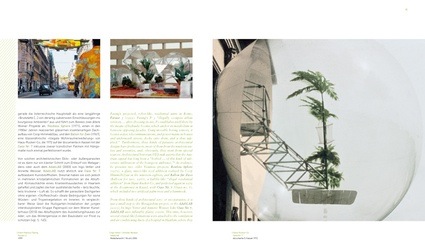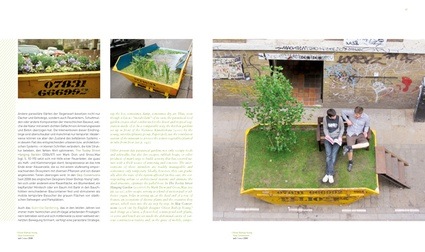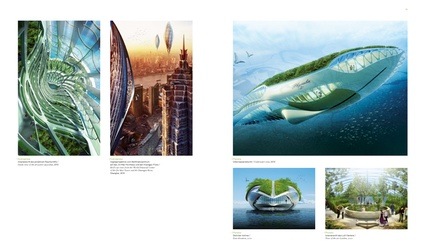(Re)Designing Nature – Current Concepts for Shaping Nature in Art and Landscape Architecture, edited by Susanne Witzgall, Florian Matzner, Iris Meder, Künstlerhaus Wien (available on Amazon USAand (Re)Designing Nature: Current Concepts for Shaping Nature in Art and Landscape Architecture: Aktuelle Formen der Naturgestaltung in der Bildenden Kunst und Landschaftsarchitektur.)
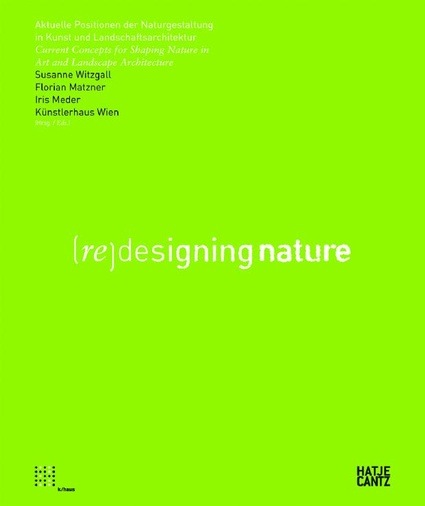
Publisher Hatje Cantz writes: (Re)Designing Nature features innovative design concepts for nature in an urban context. The publication inspires readers to contemplate our current relationship to nature, and animate present-day debates about socially correct, ecologically sustainable, and aesthetically contemporary environmental design. Changes in nature and their ecological consequences have taken on acute dimensions these days. Rapidly growing mega-cities, for one, and shrinking cities, for another, call for new ideas and models for dealing with urban nature. Artists and landscape architects present concepts for the alternative use of vacant city lots and old industrial areas, design parasitical gardens in the middle of the city, or utopian visions for a future symbiotic networking of culture and nature.
Before i start my enthusiastic review of the book i need to get one thing out my chest: “What were the designers thinking?” The book is written in both german and english. Alles ist gut if you speak german: you get a clear black font. However, if you only understand english then prepare your reading glasses or your magnifier because the pale green font used for the english version of the text is a pain to decipher.
Now let’s proceed…
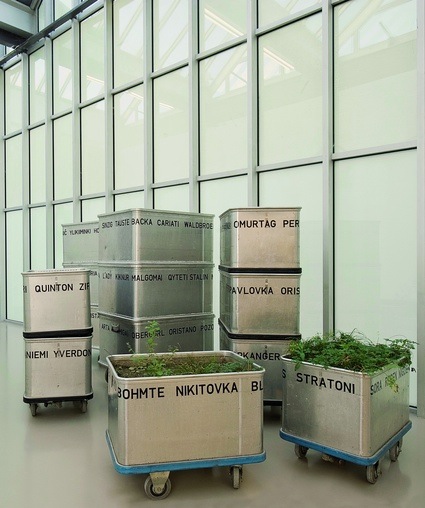 Lois Weinberger, Mobile Landscape, 2003. Installation view at Institut d’Art Contemporain Villeurbanne. Photo: Institute d’Art Contemporain Villeurbanne
Lois Weinberger, Mobile Landscape, 2003. Installation view at Institut d’Art Contemporain Villeurbanne. Photo: Institute d’Art Contemporain Villeurbanne
(re)designing nature is the catalogue of a show that closed a few weeks ago at the Künstlerhaus, Vienna. Last year and the year before i kept complaining of the many, far too many, art exhibitions i had seen around Europe that dealt with art and design tactics that engage with climate change, new models of sustainability and more generally our relationship with nature. The artworks selected were not at fault. What irked me with many of these shows is that they felt like they were organized too fast, because suddenly the words ‘ecology’ and ‘sustainability’ were splashed across the front page of magazines, because that’s what got the attention of the public or maybe just money from the sponsors. Artworks and artists traveled by planes, lush catalogues were printed, fancy opening parties were thrown. I’m sure the Vienna show had its fair share of parties and flying around but the tone of the essays, and the selection of works in (Re)Designing Nature have a more mature, reflected aura. The Vienna exhibition opened months after the others had closed but instead of looking like the slow learner, the show appears to be the only one in the class that has taken enough time to reflect on the issues at stake and see through the hype. Actually, the curators did such a thorough, serious job that several of the works in the catalogue lack in instant appeal. They don’t even photograph well. But if you go beyond that first disappointment (because i was disappointed at first, used that i am to open a volume on amazing photos and graphics) you realize that the projects make sense. Some of them are utopian without ever falling into the trendy trap, others relate successful experiences, others are simply clever enough to make you ask yourself the right questions.
According to curators Iris Meder, Susanne Witzgall and Florian Matzner, contemporary landscape planners, artists and architects are adopting 3 different strategies to engage with nature in problematic urban areas. A first one looks for ways to protect what nature is already existing in urban center or to convert post-industrial areas into gardens. A second approach provides the frameworks, and the tools for agricultural and participatory projects. The last one explores parasitic structures and symbionts.
A few projects featured in the book and exhibition:
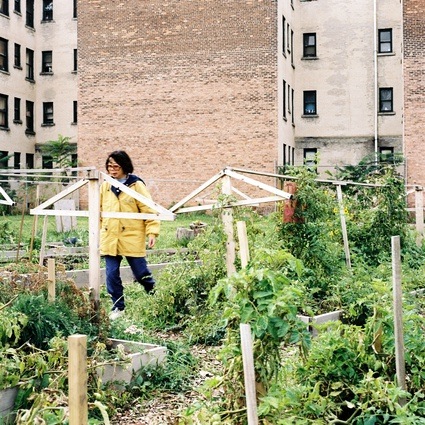 Ingo Vetter, Detroit Industries, Urban Agriculture, 2003
Ingo Vetter, Detroit Industries, Urban Agriculture, 2003
Detroit used to be the automobile capital of the world. Since the early sixties, however, Ford, Daimler-Chrysler, General Motors have been moving their production plants either to the south of the USA or to Central or South America. Hit by the more recent economic downturn, Detroit saw its residential lot vacancy rise to 27.8% in 2009, up from 10.3% in 2000. About 3,000 empty residential structures were torn down in 2010.
Attempts at self-organized community projects using the empty surface of the inner city for agriculture and horticulture emerged in the early ’00s. People would either buy land or just occupy it, turning a former industrial city into urban villages. In 2003-2004, Ingo Vetter’s Detroit Industries – Urban Agriculture documented the gardens growing food right in the middle of the decaying city. Grassroot, community-led urban agriculture has now been officially identified as a valuable part of the city’s transformation.
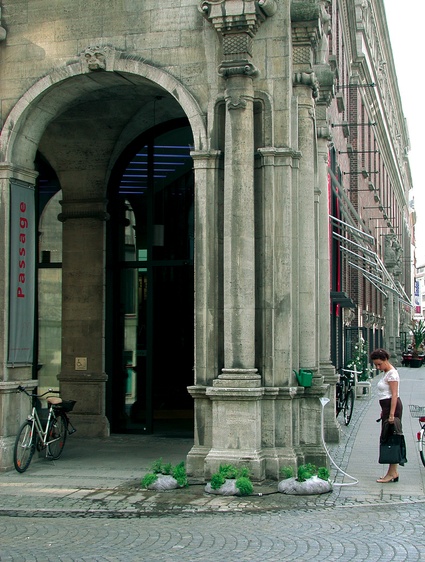 N55, City Farming Plant Modules, Bremen, 2003
N55, City Farming Plant Modules, Bremen, 2003
N55’s City Farming Plant Modules enable city dwellers to grow plants in the streets, directly onto the pavement. The flexible plant modules are watered by hoses connected to drain pipes on buildings or to any other water source. Rainwater penetrate the fibre cloth, which will retain moisture while allowing excess water to escape.
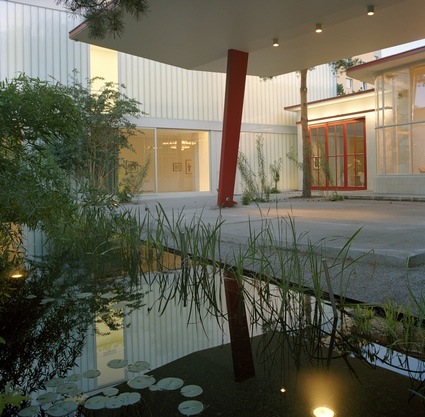 Hager Landschaftsarchitektur, Filling Station Garden, 2008. Photo: Annette Kisling
Hager Landschaftsarchitektur, Filling Station Garden, 2008. Photo: Annette Kisling
Swiss architecture studio Hager Landschaftsarchitektur ingeniously turned an abandoned gas station dating back to the 1950s in Berlin’s Schöneberg district into an enclosed city garden.
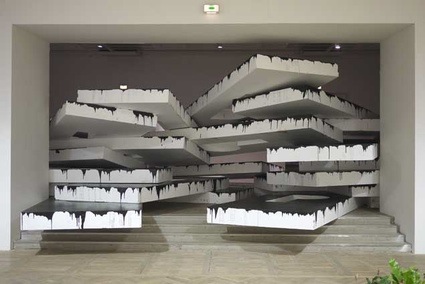 Observatorium, Into the Desert, installation at the Stiftersaal, Künstlerhaus, Vienna, 2010. (photo by FLOLO)
Observatorium, Into the Desert, installation at the Stiftersaal, Künstlerhaus, Vienna, 2010. (photo by FLOLO)
Observatorium piled up Styrofoam parking lot strips to a huge heap in the entrance room of the exhibition. The installation “Into the desert” points to motorized traffic as being an essential landscape element.
Architect and author Paul Shepheard
In Houston and other car-heavy cities of the U.S. every threshold experience is made similar by th eawalk from the parking lot to the building through ranks of cars; it is a powerful but not unpleasant phenomenon and a real landscape event.”
each of the 28 artists and landscape architects as well as the 3 curators of the show are represented by a parking lot space
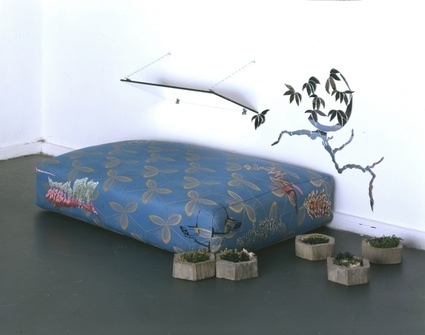 Isa Melsheimer, Square, 2004. Photo: Roman März
Isa Melsheimer, Square, 2004. Photo: Roman März
A simple blue and gold mattress is embroidered with graffiti saying “monolithic super-lanscape”, “controlled consumption” or “zoning”. CCTV cameras mark one of its corners, they seem to monitor the surrounded area. Weeds grow into concrete bowls. A mirror hangs above the scene. Platz/Square recalls the soulless design of many urban ‘green’ spaces, as well as the gradual loss of open public space in the city, due to privatization and the attempt to maximize profits.
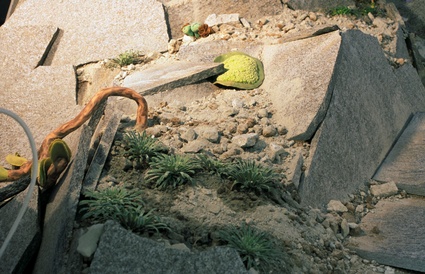 Reiner Maria Matysik, Alpinum, View of installation, Kunsthalle Bern, details, 1999 (Vorläufer für Brache / Predecessor for Urban Wasteland, 2010)
Reiner Maria Matysik, Alpinum, View of installation, Kunsthalle Bern, details, 1999 (Vorläufer für Brache / Predecessor for Urban Wasteland, 2010)
Reiner Maria Matysik‘s ‘post-revolutionary forms of life’ are models of synthetic organisms elaborated in labs. A mix of plants, animals, mushrooms, bacteria, viruses and prokaryotes they can walk, roll, jump, crawl. Some emit electrical field, others ultrasonic sounds. Resistant and highly adaptable, they don’t fear global warming nor the collapse of human civilization.
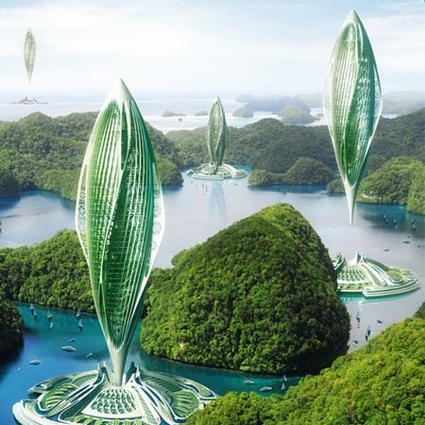 Vincent Callebaut‘s Hydrogenase (warning, the music on the project page might have you deeply embarrassed if people are around you right now) proposes a concept of emission-free habitable airships powered by seaweed. Callebaut claims that the energy obtained by farmed algae would be superior to any current biodiesel or bioethanol production.
Vincent Callebaut‘s Hydrogenase (warning, the music on the project page might have you deeply embarrassed if people are around you right now) proposes a concept of emission-free habitable airships powered by seaweed. Callebaut claims that the energy obtained by farmed algae would be superior to any current biodiesel or bioethanol production.
The vessel would be used as flying hospitals or to provide food or even disaster relief to areas that cannot be accessed by road or that do not have an airport nearby. The vertical structure of the Hydrogenase doesn’t indeed require a runway to take off or land.
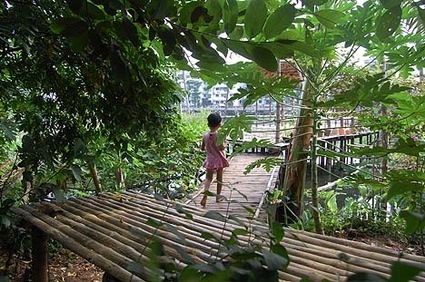 Khondaker Hasibul Kabir, Ashar macha / Platform of Hope, 2009
Khondaker Hasibul Kabir, Ashar macha / Platform of Hope, 2009
Landscape architect Khondaker Hasibul Kabir lives in the largest slum of Dhaka, the capital of Bangladesh and the “world’s fastest-growing megacity.” Many of the inhabitants of the slum are illegal immigrants from various parts of the country. He involved both the immigrants and his students at the BRCA University in a series of self-help projects that involved the creation of gardens, the building of a bamboo platform over the river, the erection of a library, the planting of resistant plants that even flourish on contaminated soil.
Views inside the book:
